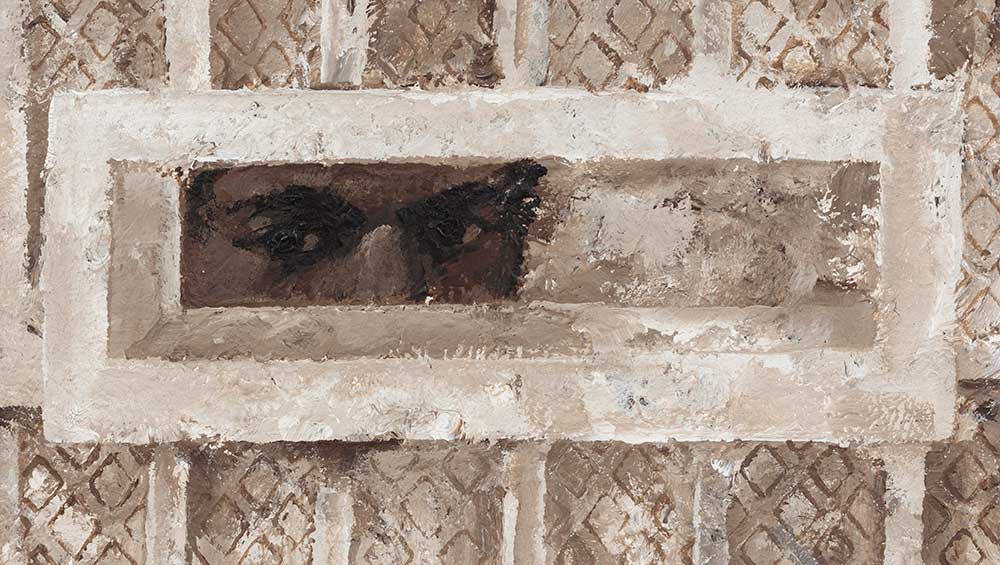
Martin Wong, Cell Door Slot, 1986 (detail). Acrylic on canvas, 45.7 x 71.1 cm. Courtesy of the Martin Wong Foundation and P.P.O.W, New York. © Martin Wong Foundation.
Camden Art Centre, London
16 June – 17 September 2023
by JOE LLOYD
No one painted brick quite like Martin Wong (1946-99). In his 1980s peak, the all-too short-lived American artist transformed the reddish-brown tenement houses of the Lower East Side into the stuff of nightmares. In Stripped Trans Am at Avenue C and Fifth Street (1984), two battered specimens, part-ruin, seem all that’s left in the world, except a similarly corroded car. They stand alone in a wasteland beneath a Ragnarok-red sky, part-castles, part-anthills, the last redoubt of humanity in a broken world. Wong’s bricks seem to inch out of his paintings, insisting on themselves as objects rather than subjects of an artwork. He might be the late 20th century’s answer to John Martin. In No Es Lo Que Has Pensado … (It's Not What You Think …) (1984), two figures embrace below a Frankenstein’s monster of roughly stitched-together bricks. Painted in acrylic, the wall is scarred and bruised like flesh. The building, forbidding as it is, seems to provide shelter from whatever hell lies beyond. In Everything Must Go (1983), however, a block has finally collapsed, looked over by the stars.
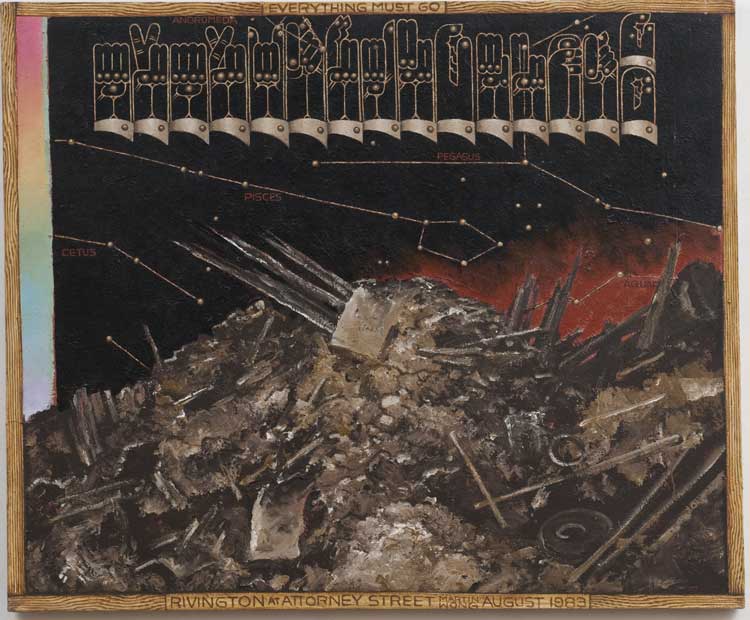
Martin Wong, Everything Must Go, 1983. Acrylic on canvas, 121.9 x 152.4 cm. Courtesy of the Martin Wong Foundation and P.P.O.W, New York. © Martin Wong Foundation.
Wong, who is now the subject of a touring retrospective, Malicious Mischief, which has just alighted at Camden Art Centre in London, reflects some of his 80s New York contemporaries in using the aesthetics of the apocalypse to depict the hell of the present. Where Wong differs from some others, however, is that he was a remarkable painter. He was also a very diverse one. He could capture domestic interiors like a turn-of-the-century realist, as in My Secret World (1978-81), which depicts his room at Meyer’s Grand hotel where he worked as a night porter for three years.
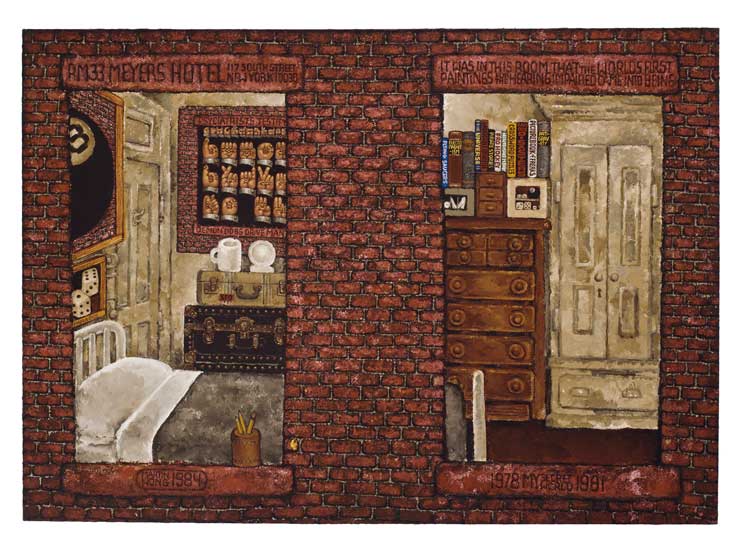
Martin Wong, My Secret World 1978-81, 1984. Acrylic on canvas, 121.9 x 172.7 cm. Courtesy of the Martin Wong Foundation and P.P.O.W, New York. © Martin Wong Foundation.
His skill in trompe l’oeil is particularly breathtaking. His 1986 exhibition The Last Picture Show (1986) featured 10 large paintings of boarded-up storefronts from Avenue B, with their lowered shutters and gates. He captured the area as the very first saplings of gentrification began to sprout. There is a shop advertising Puerto Rican poetry, its windows closed as if to hide from the trends outside. Another has a shutter rendered in loving detail, with impasto splotches capturing wear and tear. In the exhibition’s press release, Wong reiterated “everything must go”. But these paintings seem to want to preserve New York as it once was.
Although Wong’s golden years belong to the Big Apple, he started out in its continental and dispositional opposite. He was born to Chinese American parents in Portland and grew up in San Francisco’s Chinatown. His initial studies were in ceramics, including a humanoid coyote and the demonic Love Letter Incinerator $ (1970). He spent a period living in Haight-Ashbury and became a hippy – a confident self-portrait (1974-75) from the time shows him long-haired and floppy-hatted, clad in a red shirt and yellow-and-blue tie.
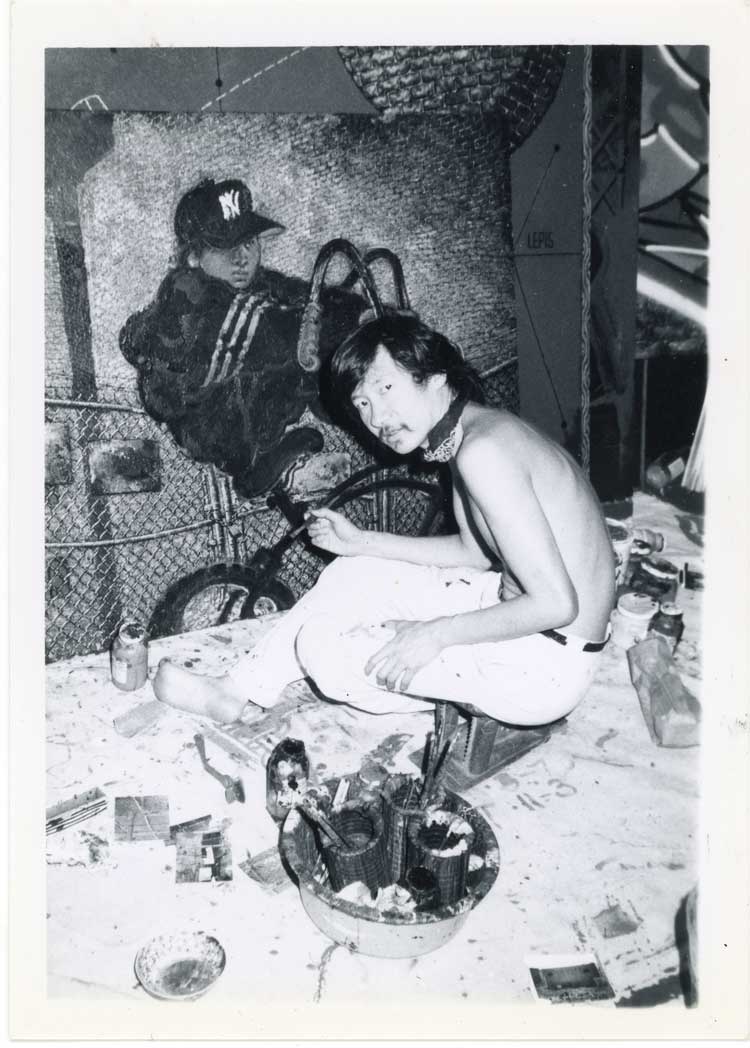
Portrait of Martin Wong (in exchange for drawings) by Baird Jones, NYC, 1984. Courtesy of the Martin Wong Foundation.
Wong designed sets and costumes for the performing arts troupe the Angels of Light, whose interests read like an A-Z of West Coast counterculture: altered states, Buddhism, communes, the Diggers. But there was a playfulness to his engagement. Tibetan Porky (1975-78) turns the Looney Tunes character into an Indian deity. He set up a portrait business called Human Instamatic, charging $5 for a drawn portrait and $25 for a painted one. His early work captures the sun-kissed characters of California’s summer of love, often with a wry eye. Untitled (Jesus Tattoo) (1978) sketches a man with a huge tattoo of a rather alarmed looking Christ on his back. Wong depicts the saviour with bulging eyes, red pupils and an anxious expression, as if perturbed to find himself trapped once more in human flesh.
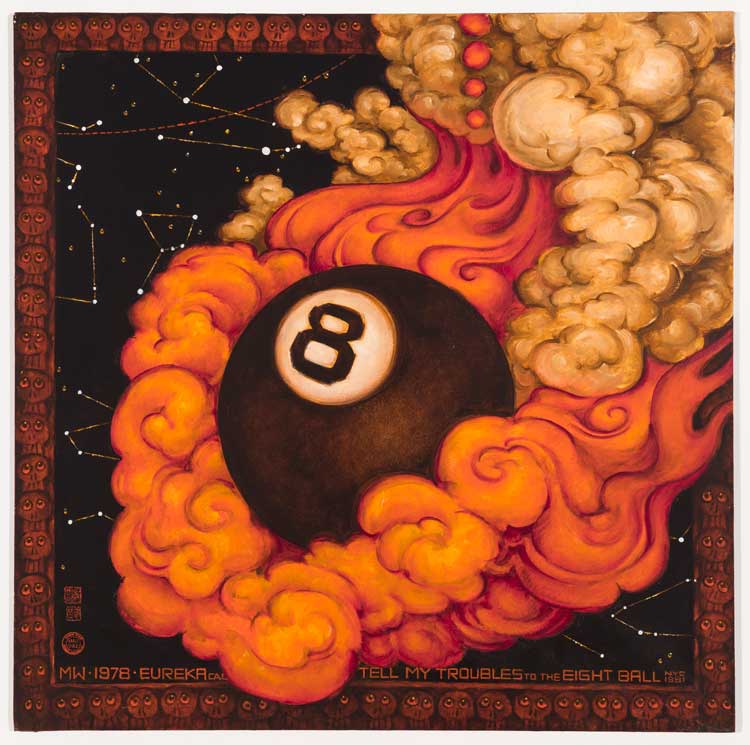
Martin Wong, Tell My Troubles to the Eight Ball (Eureka), 1978-81. Acrylic on canvas, 121.9 x 121.9 cm. Courtesy of the Martin Wong Foundation and P.P.O.W, New York. © Martin Wong Foundation.
In 1978, Wong moved to New York to develop his artistic career. Installed at Meyer’s for the first three years, he worked rapidly and intensely. Manhattan was at its most decayed, a city given to the vultures. Wong’s style almost immediately adapted his work to this new situation. The bricks quickly took control. Living in relative isolation, Wong threw himself into reading everything from world mythology to gay erotica. He was particularly obsessed with astrology. Tell My Troubles to the Eight Ball (Eureka) (1978-81) sees a fortune-telling tennis ball streaking through the sky, surrounded by cloudy spirits like those in Himalayan art.
Two meetings would bring Wong’s art to its peak. The first was a chance encounter on the subway with a deaf person. This inspired Wong to start placing (often obscene) messages into his paintings using the American Sign Language (ASL) alphabet. These recur time and again. They become a literal code and a symbolic one, standing for the secret languages of minority groups. This interest in the language and expression of the marginalised continued throughout his life. Later, Wong started collecting graffiti before it could be removed, in a bid to protect what he called the “last great art movement of the 20th century”. With help from an investor, he even opened a Museum of American Graffiti in 1989; the collection is now in the Museum of the City of New York.
The second encounter was with an entire community. In 1982, Wong moved to a part of the Lower East Side known for its predominantly Puerto Rican (or Nuyorican) inhabitants. He quickly made friends with the poet, actor, activist and petty criminal Miguel Piñero, who became Wong’s muse and sometime partner, before his death from cirrhosis in 1988. The Portrait of Miguel Piñero (1982) shows him writing, eyes hidden by hair, beneath skyscrapers and a message in sign language. The canvas is tall and thin and Piñero appears as if incarcerated by the city’s watchtowers.
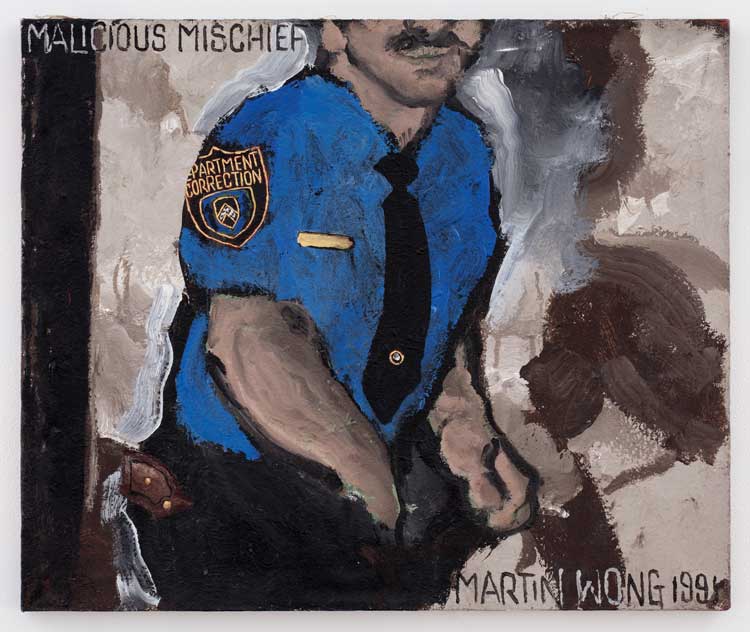
Martin Wong, Malicious Mischief, 1991. Acrylic on canvas. Courtesy of the Martin Wong Foundation and P.P.O.W, New York. © Martin Wong Foundation.
Piñero had spent time in prison in the 1970s, where he wrote the play Short Time, which brought him literary renown. Inspired by Piñero’s experience and that of his fellow ex-convicts, Wong started making work that dealt with the US prison system. He sought to find moments of eroticism within even the most oppressive structures. Come Over Here Rockface (1994) shows a prisoner soliciting a guard. In Malicious Mischief (1991), a guard is caught jacking off. We only see his torso and the lower half of his face; the trigger for his moment of pleasure is concealed.
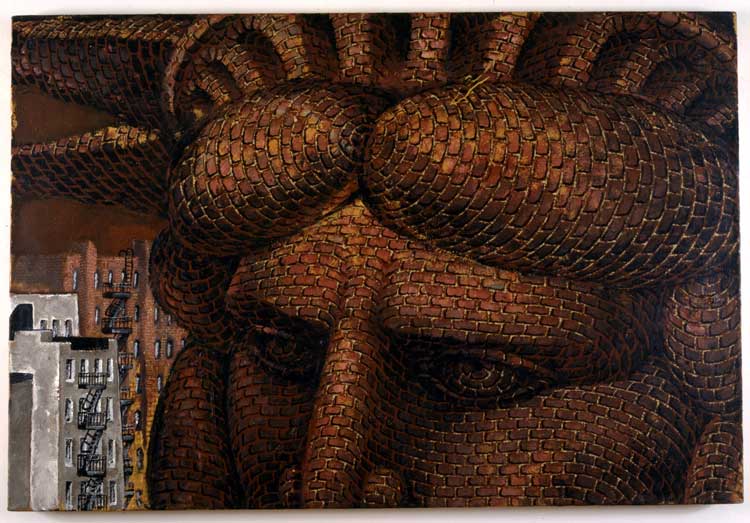
Martin Wong, Mrs. Liberty Face, 1990. Acrylic on linen, 80.1 x 118.1 cm. Courtesy of the Martin Wong Foundation, P.P.O.W, New York and Galerie Buchholz © Martin Wong Foundation.
For all the oppressiveness of his vision, Wong is often hilarious. Untitled (Brick TV) (1983) is what it sounds like: a shoddy old TV set whose screen has been painted over with the artist’s characteristic blocks. Many of his later works seem to make fun of his own obsessions. Mrs Liberty Face (1990) gives us a close-up of a brown brick Statue of Liberty. Orion (1990-91) is an enormous brick penis surrounded by constellations, presented in a gilded rococo frame. I find Wong’s 90s works largely lack the transcendence of his greatest output, though a series of works that engage with his Chinese heritage contain fascinating meetings of traditional and popular culture.
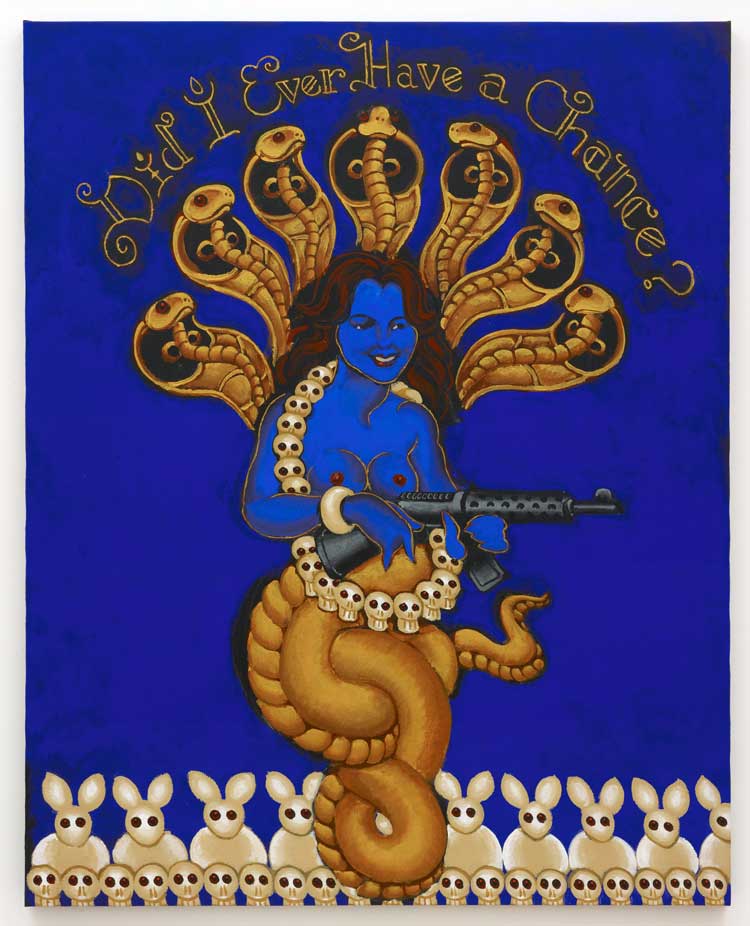
Martin Wong, Did I Ever Have a Chance, 1999. Acrylic on canvas, 154.9 x 121.9 cm. Courtesy of the Martin Wong Foundation and P.P.O.W Gallery, New York © Martin Wong Foundation.
Wong was diagnosed with pneumonia in 1994, which was soon discovered to be Aids-related. He moved back to his parents’ house in San Francisco. An almost unbearably bittersweet film by Charlie Ahearn, Martin Wong, 1988, captures the artist towards the end of his life, dining out with friends and family, causing mischief, and continuing to paint despite his advanced infirmity. His final work, Did I Ever Have a Chance? (1999), took him back to his hippy days: a gun-toting Patty Hearst is morphed with the Hindu goddess Kali, the deity of war and death. It is perhaps the wrong question to ask. Wong did have a chance. And he seized it, creating a body of work that remains among the most bracing and fascinating of the past half-century.